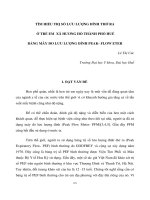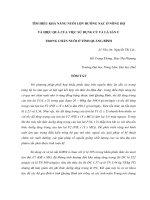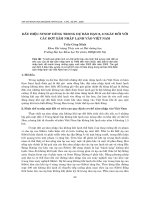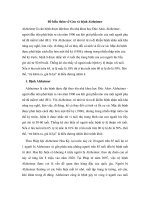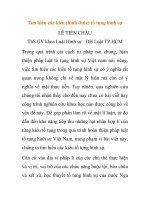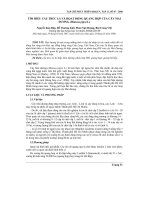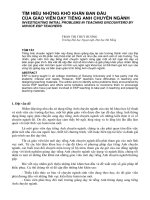Báo cáo nghiên cứu khoa học: "Tìm hiểu về bệnh đường hô hấp ở nước Lào" pdf
Bạn đang xem bản rút gọn của tài liệu. Xem và tải ngay bản đầy đủ của tài liệu tại đây (62.25 KB, 13 trang )
413
JOURNAL OF SCIENCE, Hue University, N
0
61, 2010
HEALTH SEEKING BEHAVIOR ASSESSMENTS FOR RESPIRATORY
ILLNESS IN THE LAO PEOPLE’S DEMOCRATIC REPUBLIC (LAOS)
Vanphanom Sychareun
1
, Visanou Hansana
1
, Bouachanh Sengphilom
1
, LatsamyOulay
1
,
Vatsana Thamavongsa
1
, Vatsana Somphet
1
, Chansathit Taykeophithoune
1
,
Soudavanh Nathavong
1
, Johnly Phanthady
1
, Phetsavanh Chanthavilay
1
,Bounthanom
3
,
Mayfong Mayxay
1, 2
1
Faculty of Post Graduate Studies, University of Health Sciences, Vientiane, Lao PDR
2
Wellcome Trust – Mahosot Hospital – Oxford University Tropical Medicine Research
Collaboration, Mahosot Hospital, Vientiane, Lao PDR
3
National Center for Laboratory and Epidemiology, Vientiane, Lao PDR
SUMMARY
Respiratory illness (RI) remains a public health problem in Laos, but little is known
about its burden and people’s health seeking behavior. Among 1,751 households (9,114 people)
studied, 3.5% (317/9,114) had RI (fever, cough, and sore-throat) 30 days before the survey
[6.3% in rural and 2.3% in peri-urban areas (P<0.001)]. Of all sick persons, 77% sought
treatment [94% in peri-urban and 48% in rural areas (P<0.001)] and 31.5% of them self-
medicated [55.5% in peri-urban and 29% in rural areas (P<0.001)]. Sick people in peri-urban
areas preferred to chose private clinics and pharmacies as their first treatment option while in
rural areas they frequently consulted with village health volunteers and visited the health centre
as their first choice. Distance, costs of care, and service availability are the most important
determinants of seeking care. The differences in the RI burden and health seeking behavior
between the two areas of Laos are probably due to the difference in health service availability
and socio-economic status
Keywords: Respiratory illness, health seeking behaviour, Laos
1. Introduction
Respiratory illness is a leading cause of death and disease burden worldwide
(Bryce, 2005) and about 95% of the deaths occurred in developing countries (Wardlaw
et al., 2006). In the Lao PDR (Laos), it is an important cause of morbidity and mortality,
particularly among children, but very little is known about its burden. The latest
national health survey in 2000 demonstrated that about 1% of under-five children had
acute respiratory infection in the past two weeks before the survey (NSC, 2001). The
respiratory illness surveillance system had not existed in Laos until recently but this is
414
only facility-based, with disease reports originating from hospitals and health centers.
Therefore, the capacity of this surveillance system to reflect actual disease burden in the
community may be limited.
Because health seeking behaviors and health care utilization practices vary
widely from community to community, health utilization assessments can assist in
identifying the extent to which facility-based data reflects actual burden of disease in
the community. In addition, understanding community patterns of health seeking
behavior and who in the community are the first points-of-care for villagers within the
context of respiratory illness and reporting would improve public health practice in the
community. The survey was conducted to provide better direction for Lao public health
program and policy planners to improve public health practice, surveillance systems,
and prevention strategies and generate important information to help evaluate ongoing
Lao Government health activities.
2. Methods
2.1. Study sites
The study was conducted in peri-urban (Vientiane Capital and Vientiane
Province) and rural (Sayabouly and Sekong Provinces) areas. These localities were
chosen because they cover the range of peri-urban and rural areas which are sites for the
development and piloting of village-based mechanisms to promote human and animal
avian influenza surveillance and response, and had previous avian influenza or
influenza-like outbreaks. Vientiane Capital and Vientiane Province are located in central
Laos with 9 and 13 districts, respectively comprising of both urban and peri-urban areas
and one peri-urban district from each was studied. Sayabouly Province is located in
northern Laos on the Lao-Thai border with 10 districts which comprise of largely rural
areas, with some being very remote and poor. Sekong Province is located in southern
Laos on the Vietnam border with four districts comprising of rural areas and multiple
ethnic minority groups (NSC, 2006). One rural district from each of these provinces was
selected for the study.
2.2. Sampling procedure and survey
The provinces and districts were purposively sampled as mentioned above while
the villages were randomly selected from the village list of each district. Three villages
were randomly selected from each district and all households in the village were studied.
All members of the households were eligible for the survey. An individual was
considered a member of a household if he/she had slept within that compound for at
least six of the preceding twelve months. Household members who died within 30 days
before the survey were also included as they might have had an episode of respiratory
illness.
415
Following a verbal consent, the recognized head of the household and older
caregivers (at least 15 years of age) served as proxies for non-adult household members
and for adult household members not present or not able to answer the questionnaire
were interviewed. A designed structured questionnaire comprising of socio-
demographic information, household members’ respiratory illness and health seeking
behavior, and the household and animal care practice was used to collect information.
Sixteen focus group discussions (FGDs) were conducted (eight in each urban
and rural area). The participants in the qualitative study were recruited from those who
took part in the questionnaire interviews. Eligible participants were selected purposively
based on their experiences of having at least one of their family members had ARI
symptoms at least during last month and their willingness to participate. There were
seven to eleven participants per FGD with varying occupations, ages and educational
backgrounds. Each FGD lasted approximately 1-1.5 hours and was tape-recorded.
Translators were used to conduct FGDs in the rural areas with some ethnic minority
women. The tapes and notes of the FGDs were transcribed in Lao and then translated
into English.
Definition of respiratory illness
The definition for respiratory illness was derived from the WHO case definition
for influenza (WHO) and defined as new fever with sore throat and/or a cough in the
absence of other diagnoses during the 30 days before the survey.
2.3. Sample size determination
Assuming that 2.2% of all individuals would have had an episode of RI within
30 days preceding the assessment (Clague et al., 2006) with an alpha of 0.05 and
estimated precision of 1%, the sample size of 865 households was needed. But the
calculated sample size was adjusted for a design effect of 2.0 to account for correlations
within clusters; therefore a total of 1,751 households should be included.
2.4. Data analysis
Quantitative data were analyzed using Stata v9 (StataCorp, College Station, TX,
USA). Comparisons between two groups were made using Chi-square, Fisher’s Exact,
Student-t, and Mann-Whitney U tests as appropriate. Logistic regression analysis was
performed to identify determinants of seeking different types of health care.
Qualitative data were analyzed using a participatory process in parallel with
software-based analysis using MAXQED. Transcripts were read and reread and open
codes developed to capture emerging themes in the data. Then the key themes and
concepts from the English transcripts were identified. The themes were systematically
catalogued across all focus groups. The description of how the themes were described
and explained by the FGD participants was then made. Finally, the themes were
416
compared across major subgroups of participants.
3. Results
Of all 1,872 households and 9,703 villagers in the target study sites, 1,751
(93.5%) and 9,114 (94%), respectively were included in the study. The reasons for non-
recruitment were that the household members were not in the villages during the survey
or moved away.
3.1. Socio-economic-demographic characteristics of study households and
population
Of all study population 50% were males, 72% were from peri-urban area, and
66% were Lao Leum (lowland Lao people). The median (IQR) age of all study villagers
was 23 (11-39) years and 34% of them were children < 15 years. The median (IQR)
highest schooling years in the households was 10 (5-11) and 62% were classified as
poor. The overall mean (95%CI) number of bed-rooms in the households was 2.2 (2.1-
2.3) and 98% of all households used a wood/charcoal stove for cooking. The mean
(95%CI) number of household members who smoked inside the houses was 1.5 (1.4-
1.6).
3.2. Respiratory illness burden and disease severity
The proportions of persons and households with respiratory illnesses within 30
days before interview were 3.5% (317/9,114) and 15% (264/1,751), respectively. Of 317
ill persons (53% males), 156 (49%) were from peri-urban areas. The overall median
(IQR) age of ill people was 17 (5 – 40) years with 49% of them were children < 15
years and 14% were under five children. Among those who were reported to be ill, 219
(69%); 77 (24%); and 21 (7%) were classified as mild, moderate, and severe,
respectively and 8 (3.5%) were admitted to hospital with a median (IQR) length of stay
in hospital of 4.0 (2.5-4.5) days. The overall median (IQR) duration of the illness was 4
(3-7) days. Fever, cough, sore-throat, runny nose, headache, muscle ache, difficult or
fast breathing, chill, wheezing, and nausea or vomiting were present in 100%, 90%,
83%, 70%, 65%, 58%, 42%, 30%, 21%, and 18.5%, respectively.
The disease severity was not significantly different between children and adults
(P=0.35). Except for muscle pain, which was significantly more frequent in adults
(66%) compared to in children (49%) (P=0.005), other symptoms and signs were
similar between the groups. The median (IQR) days of illness was also statistically
longer in adults than in children [5 (3-7) vs 4 (3-7), P=0.02].
Of 229 adults with respiratory illness, 143 (62%) were absent from their daily
work during their illness and 65% of their family members were also absent from their
daily activities to look after them.
417
3.3. Factors associated with respiratory disease burden
The proportion of the households using charcoal/firewood stoves for cooking
was significantly higher among those with RI persons (77%) compared to 62% in the
households without RI persons (P<0.001). The frequency of the households situated in
very smoky environments was also statistically higher in the households with RI
patients than those without [43% vs. 25% (P<0.001)]. The percentages of the
households with sick and dead animals, and with animals slaughtered within 30 days
before the interview were significantly higher in the households with RI patients than
those without [14% vs. 7% (P<0.001), 13% vs. 7% (P<0.001), and 74% vs. 65%
(P=0.001), respectively].
In a univariate analysis, the villagers who lived in peri-urban areas, Lao Leum
ethnic group, literacy of the family heads, and higher socioeconomic status were
significantly associated with seeking care for respiratory illness (P<0.001 for all).
However, in a multi-variate analysis, only the peri-urban residents were independently
correlated with seeking care for RI illness (P<0.001). Villagers’ sex, age, and disease
severity were not significantly associated with RI seeking care.
3.4. Treatment seeking behavior and preference
Of all villagers with respiratory illness, 225 (71%) sought treatment. Among
those who did not seek treatment, 38% thought their illnesses were just mild and would
be self-limited, and 33% of them said they were not able to afford the treatment and
transportation costs. More than half (59%) of the villagers who did not seek care said
they just rested at home, while 31.5% of them self-medicated at home.
The first treatment places/health providers chosen by these people were private
clinics (29%), health centers (19.5%), pharmacies (15%), village health volunteers
(15%), district hospitals (5%), central hospitals (4%), provincial hospitals (3.5%), and
mobile clinics (1.3%). A small proportion (1.4%) of these people went to see traditional
or spiritual healer as the first choice for their illnesses.
The most frequent reasons for selecting these places/health providers as the first
choice were that it was close to their house (70%); they had good experience at those
facilities/health providers (36%); it was cheap (29%); it provided the appropriate service
for their illness (25%); offers a good quality of care (19%), and does not require much
waiting time at the facility (19%).
The median (IQR) traveling time, regardless of any transportation mode, from
their homes to health facilities was 5 (4.5-20) minutes. The most common modes of
transport used by ill people to get to the health facilities were walking (44.8%) and
motorcycle (43.9%). Eighty-two percent (260/317) of the people who sought treatment
were prescribed with medication and able to afford the treatment while 16% of them
418
could not afford the medicines prescribed by the health providers. The median (IQR)
cost of care during their illnesses was LAK 20,000 (10,000-60,000).
Comparison of treatment seeking between peri-urban and rural areas
Less sick people sought care in rural (48%) compared to peri-urban (94%) areas
(P<0.001) as they tended to rest at home more often than those in the urban-areas (63%
vs. 22%, P=0.04). There were no statistically significant differences in the reasons for
not seeking for care between the sick people who lived in rural and peri-urban areas.
Sick people who lived in peri-urban areas commonly chose private clinics
(44.9%) or pharmacies (22.5%) as the first places of care while those who lived in rural
areas frequently chose to consult with the village health volunteer (42.3%) and visit the
health centre (41.1%) as their first choice (P<0.001).
The reasons for choosing a particular facility as the first point of treatment were
as quality of care (26% vs. 6%, P<0.001), having good previous experience at the
facilities (43.5% vs. 5%, P=0.018), familiarity with heath care providers (16% vs. 5%,
P=0.018), and short waiting times required in the facilities (28% vs. 1%, P<0.001) were
significantly higher in the peri-urban than in the rural areas. More sick people in rural
areas walked to the health facility than those in the peri-urban areas (94% vs. 17%,
P<0.001), but more villagers in the peri-urban area used a motorcycle as their mode of
transport when compared with those who lived rural areas (68% vs. 2.4%, P<0.001).
After seeking care, all patients (100%) in peri-urban areas received medication while
only 95% of the patients in rural area did (P=0.017).
The proportion of sick persons who could not afford treatment was also
statistically higher in rural (37%) compared to peri-urban areas (4%) (P<0.001) and the
median (IQR) cost of medication (LAK) paid by the patients was significantly higher in
the peri-urban [30,000 (15,000-80,000)] than in the rural areas [10,000 (5,000-30,000)]
(P<0.001). The percentage of sick persons who smoked was significantly higher in the
rural compared to the peri-urban areas (50% vs. 6%, P<0.001).
Qualitative data
Sixteen focus group discussions (FGDs) were conducted (eight in each urban
and rural area). The median (range) age (years) of the participants was 36.5 (19 - 60)
and 33 (18 - 46) for women in the urban and rural areas, respectively; and 37 (18 - 60)
and 30 (18 - 58) for men in the urban and rural areas, respectively. Most of the
participants were rice farmers and housewives both in peri-urban and rural areas.
The order of seeking care and different factors in influencing sick persons as
they progress along a continuum of care was mapped (Figure 5). In general, all
participants first attempted to self-treat any illness at home. Some experiences of self-
treatment such as drinking hot water, taking a sponge bath, self-medication; especially
419
with medical herbs, were documented. More rural participants cited self-treatment than
the peri-urban participants. The reasons for self-treatment were convenience, low cost
and the perception the disease was mild. As participants from FGDs mentioned as
following:
“If there is someone in the household got sick. If they got sick and there were not
severe, they went to buy medicine by themselves. If the illness is severe, they asked
someone to buy medicines for them.” (Female, age 18-30 year old; Xayabouli\Xaya)
The decision to move from one provider to another (or from self-treatment to
seeking some form of treatment) was commonly influenced by illness severity and
treatment failure such as no improvement in the patient’s condition, and a lack of
medicines. Rural areas are considered by FGD participants as being characterized by
constrained access, in terms of infrastructure and distance, together with higher direct
and indirect costs for seeking care. Because of these barriers, they state they will seek
formal health care (e.g. health centre, hospitals) only when very ill, unlike their
counterparts in urban areas who seek informal care (e.g. pharmacy) even in cases of
very mild illness. Given the higher costs and constrained access, participants in rural
areas, care-seekers tended to revert to whatever providers are available to treat illness.
These participants often used village health volunteers, but also turned to illegal
physicians (unregistered providers of medicine and health advice), spirit healers,
traveling traders, or self-treatment with herbal medicines in equal numbers. Other than
specific cultural beliefs about spirit healers held by a small number of participants,
informal health options available in rural areas are not preferred, but are used as the
only option available because all other options are too expensive and too far away.
When people in remote, rural areas say they have “sought treatment” the reality of the
type and quality of treatment is quite different from that of those in peri-urban or less
remote settings. The availability of service providers in rural areas was also much more
constrained. VHVs and health centers would sometimes not have the medicines needed
for illness; further, the equipment and acceptability of care at each place was considered
subpar by some participants.
Cost, distance, and service availability were the primary factors, acting as
barriers to participants in rural areas accessing formal health services; while cost,
service availability and trust were the important factors to accessing different options of
health care providers and not as barriers. Rural participants were less likely to be able to
seek any kind of formal health care for illness. Clearly those in urban areas have many
more options to choose from, and thus have more ways of comparing different options
and choosing where to seek care. They are very likely to receive some form of treatment
than those in rural areas. While the central hospital is considered very expensive, most
people in VTE municipality would still seek care there if they had a severe illness.
Further, when cost is relatively the same for two or more options, those in urban areas
420
look to quality and the range of services offered to decide which to choose. There are
more options and alternatives to care in the urban areas, so if one option (central
hospital) is too expensive, there are many other options to choose from – i.e. private
clinics, provincial hospitals, and district hospital (especially if they have insurance card).
As participants from focus group discussions mentioned:
“Going to a district hospital is more complicated with many steps. I do not like
to go there. Seeing doctors at the private clinic is better because it is the same doctor
as in the district hospital while cost is 25,000 LAK.” (Female, 18-30 years, VTE
capital)
4. Discussion
To the best of our knowledge, this is the first study on the burden of and the
health care seeking behavior for respiratory illness conducted in Laos. The overall
proportion of the persons with respiratory illness within 30 days before the survey was
3.5%, half of them were children < 15 years, and 14% were the children under five. This
figure was considered to be considerably high and might be much higher than this if the
survey had been carried during the winter. The Lao national health survey in the year
2000 revealed that ~ 1% of the children under-five had acute respiratory infection in the
past two weeks before the survey (National Health Survey, 2000). The overall frequency
of the people with respiratory illness in the present study was higher than the prevalence
of influenza in rural Thailand (2.2%) in the 30 days preceding the assessment (Clague et
al., 2006). A study in rural Uganda demonstrated that of the 323 Uganda children aged
< 2 years, 37% had upper respiratory tract infection within 2 weeks before the survey
which was much higher than that found in our study (Mbonye, 2003). The prevalence of
acute respiratory infection in the 2 weeks before the study among Saudi Arabia children
aged < 2 years was 24% (Saeed and Bani, 2000). However, it is very difficult to
compare the prevalence of respiratory illness between one to another study since the
definition of the disease used may differ and the study settings are also different.
The proportion of persons with respiratory illnesses in the present survey was
significantly higher in the rural than in the peri-urban areas, probably due to the poorer
socioeconomic; environmental; and hygienic conditions in the rural areas. The higher
prevalence of respiratory illnesses observed among the rural, disadvantage groups such
as poor (compared to non poor), ethnic minorities of poor socioeconomic status
(compared to better socio-economic condition), and children under five years old
(compared to adults) reiterates the relationship between poverty and morbidity which
are documented in previous literature (Bloom et al., 2004; Sen 2003; Wagstaff 2002;
Lahelma and Arber, 1994).
In this study, the frequency of the persons with respiratory illness who sought
treatment was ~ 71% which was also considered to be high. The Lao national health
421
survey in 2000 demonstrated that the proportion of the people who suffered from any
illnesses in the two weeks preceding the survey and sought care was only 47% (NSC,
2001). Whether sick people seek care depends on many factors such as disease severity,
distance from home to health care facilities, availability of care service, and
affordability. Severity of the disease could not explain the high percentage of seeking
care in the present study because only 6% of sick persons were classified as having
severe disease and the proportion of the ill people who sought for care was very similar
among those who had mild, moderate, and severe disease (73.5%, 65%, and 67%,
respectively). The high rate of seeking care of the people in the present study might be
due to the care service availability in their own villages with a very short distance from
their homes. However, the care service available in the villages was only very basic
health care provided with low cost of service (e.g. ~ 2 US$ for mild and ~ 8 US$ for
severe cases). In the national health survey in 2000, the reasons for not seeking care by
the villagers were mild illness, lack of transport, long distance, and cost (NSC, 2001). In
our study, the reason for not seeking care due to inability to afford treatment and
transportation costs was about 1/3 while another 1/3 thought that their illnesses were
mild. The reasons for not seeking care of sick persons in our study are totally different
from those mentioned in a study in the Dominican Republic where the most frequent
reasons cited by the respondents for not utilizing health services were distrust of the
clinic staff, shortage of medicines, and dispersion of the rural population (Ugalde, 1984).
The frequency of sick persons who sought for treatment in our study was quite
similar to that (65-66%) found in Sri Lanka and Nigerian children who had symptoms
suggestive of malaria, acute respiratory infections, diarrhea, and measles and sought for
care (Amarasiri de Silva et al., 2001; Adegboyega et al., 2005). Three quarter of
children under five with acute lower respiratory tract infections in rural Bangladesh
sought treatment (Zaman et al., 1997). In the Dominican Republic, approximately 60%
of the children had respiratory infection in the two weeks preceding the survey sought
care from health care providers (Thind and Andersen, 2003). In rural Uganda, only
35% of the mothers seeking care for their children with upper respiratory infection and
children were taken to health units only when they developed life-threatening symptoms
(Mbonye, 2003). This was due to the high costs of care, long distances to health units,
poor attitude of health workers, lack of drugs at health units, and limited involvement of
fathers in care of the children.
Our explorative study results indicated the important role of self-treatment for
respiratory illnesses, particularly in the rural areas where the accessibility and
availability of health facilities, and affordability are limited. The reasons for self-
treatment in the present study were convenience (close distance between home and
health facility), low cost (affordability), and the diseases were mild (severity). The
options of self-treatment as the first choice were usually influenced by the perception of
422
severity. The FGDs participants in both peri-urban and rural areas in the current study
reported to choose self-medication and self-treatment as first line treatment in cases of
mild respiratory illnesses. The previous studies also found that self-treatment was quite
common when the severity of illness was perceived to be low (Stoller & Forster, 1992,
Stevenson et al., 2003; Tuan et al., 2005). In Laos, approximately 1/3 to 1/2 of the
people were self-medicated when they became sick (Vinar, 1994; NIOPH, 1999; NSC,
2001) – the findings that were consistent with that of our present survey quantitative
and qualitative data. In Guatemala, about 2/3 of the children with diarrhea and
respiratory illnesses were self-treated by their guardians or relatives and only 1/3 of
illnesses were treated by health providers such pharmacists, doctors, and personnel at
health posts and centers (Heuveline and Goldman, 2000).
A study in the Dominican Republic demonstrated that the choice of health
service utilization among children aged less than five years with respiratory illness was
determined by location (proximity) and cost (Thind and Andersen, 2003). Our
quantitative data demonstrated the difference in the health care seeking behavior
between peri-urban and rural areas. If there was no improvement following self-
treatment, sick people who lived in peri-urban areas preferred to choose private clinic
and pharmacy as their first treatment option while those in rural areas frequently
consulted with the village health volunteer and visited the health centre as their first
choice. This difference may be explained by the difference in the availability and
proximity of those health care facilities between peri-urban and rural areas. In peri-
urban areas, private clinics and pharmacies are more readily available and nearby when
compared to rural areas. In contrast, nearly no private clinics or pharmacies are
available in the rural areas, except for the health center and village health volunteer. It is
obvious that Lao villagers prefer to use the closest health care facilities because it is
convenient for them and they do not have to pay for travel cost to go to facilities further
away. The data from the national health survey in 2000 also showed that more people in
the peri-urban and urban areas went to a pharmacy when they were ill compared to
those in rural areas, but private clinics were not mentioned as a place where sick persons
visited (NSC, 2001). A study in western Nepal revealed that almost half of the
childhood illness episodes were treated by pharmacists and in 15% of episodes,
medicines were purchased from the pharmacies without consultation (Sreeramareddy et
al., 2006) because many patients cannot afford to perform the tests, doctors
recommended and therefore they consulted the nearest pharmacist.
The reasons for choosing those places/health providers as the first choice were
similar between peri-urban and rural areas (proximity, familiarity, and cost) but the
difference was that sick persons in peri-urban areas tended to think about quality of care
more than those in rural areas. Although client-perceived quality of services and
confidence in the health provider affect the health service utilization (Duong, Binns &
423
Lee, 2004), the people in rural Laos usually do not have many choices of health care
facilities in their localities. In rural and remote areas of Laos, apart from health centers
and village health volunteers, the alternative and closest places are the district or
provincial hospital, which are usually far away from the people’s villages and
sometimes it takes ~ 2-3 days by walking from their homes to such facilities as clearly
shown in our current survey. Therefore, in rural and remote areas of Laos, not only is
there a limited choices of local health care facilities, but the modern or high quality of
services is also a big challenge for the rural villagers to access.
Previous studies suggested that illness severity is an important determinant of
treatment seeking behavior (Rosenstock and Becker, 1998; Yoder and Hornik, 1996). In
western Nepal, the mothers were more likely to seek care for their sick children when
they perceived the illness as “serious” (Sreeramareddy et al., 2006) and in Bangladesh,
the mothers’ decision to seek medical care for the children having acute respiratory
infection also depended on their understanding of the disease severity (Rashid et al.,
2001). In our study, the decision to move from one health provider to another (or from
self-treatment to seeking some form of treatment) was also influenced by illness
severity and treatment failure such as no improvement and lack of medicines. The sick
persons did not usually go back to the same health care provider or facility where they
first went, but to other places. In peri-urban areas, people would seek further care in the
central hospitals where better quality of service and modern technology are available,
for example, where there are more experienced doctors and blood tests available. In
rural areas, people would like to seek further treatment in the district or provincial
hospital, but this is constrained by distance and cost. Therefore, many of them just
waited until illegal healers came to sell drugs in their villages, some of them would
alternatively see spiritual healers, and even some reported that they just waited for death
in the case of serious illness.
In the present study, a smoky environment was significantly correlated with
respiratory illness – this finding is consistent with that found in many previous studies
(Pérez-Padilla et al., 1999; Peters et al., 1999; Riojas-Rodríguez et al., 2001; Rivas et
al., 2008). This association was supported by the higher prevalence of respiratory illness
in the rural areas where the frequency of households with charcoal/firewood stove in the
houses was also very high. In rural Laos, particularly among ethnic groups, most of the
houses have this type of stove in the centre of the houses and a fire is usually made for
the whole day and used for cooking, providing warmth (during the winter), and
preventing insects flying into the house including mosquito. This can cause the
environment in the house very smoky and hence may contribute to the high prevalence
of respiratory illness.
The predictors of care seeking behavior for childhood having any illnesses (not
only respiratory infection) in western Nepal were total family income, number of
424
symptoms, mothers’ education, and perceived severity of illness (Sreeramareddy et al.,
2006). In our present survey, in a univariate analysis, the villagers who lived in peri-
urban area, Lao leum ethnic group, literacy of the family heads, and wealthier status
were significantly associated with seeking care for respiratory illness. However, in a
multi-variate analysis only the peri-urban residents were independently correlated with
seeking care for RI illness. Indeed, the people living in peri-urban areas have a
significant better economy and education; therefore they tend to seek for care much
more than those in rural areas – the reasons that were consistent with the findings in
Sreeramareddy et al., in western Nepal.
This study was conducted shortly after a big avian influenza outbreak in Laos.
Therefore, one of the objectives of the survey was also to assess the household animal-
to-animal and animal-to-human interface in the target villages in order to understand to
which extent this interface may contribute to human respiratory illness in the country.
Interestingly, the proportion of the households who reported that their livestock had
been sick and dead within the 30 days before the interview was considerably high. In
contrast, the number of the households with sick animals that had separated their sick
animals from others and declared their animal deaths was still quite low. The study
demonstrated that the dead animals were incorrectly disposed of by the villagers, and
some of them even butchered and ate the carcasses. These findings suggested a
significant high risk of the household animal-to-animal and animal-to-human interface
in the study locations, and therefore, the practical and appropriate measures to alleviate
these risks are urgently required in order to prevent further disaster from the avian
influenza epidemic in the country.
Acknowledgement
We would like to thanks all the villagers who participated in this survey. We
highly acknowledge Mr. Kongmany Chaleunvong, Dr. Andrew Corwin, Mr. William
Moss, and Ms. Brittany Moore for their technical help. Our thanks go to health staff
from Xayabouly, Hadxayfong, Phonhong, Dakcheung, and Lamam District Health for
their kind help and support during our survey. This study was financially supported by
the US CDC with facilitation from CARE International to Laos.
REFERENCES
1. Adegboyega AA, Onayade AA, and Salawu O. Care-seeking behavior of caregivers for
common childhood illnesses in Lagos Island, Local Government Area, Nigeria. Niger J
Med 14 (1): (2005), 65-71.
2. Bryce J, Boschi-Pinto C, Shibuya K, Black RE, WHO Child Health Epidemiology
Reference Group. WHO estimates of the causes of death in children? Lancet 2005; 365:
1147-52.
425
3. CARE International in Laos (CARE Lao). Community based surveillance systems in
Laos: Urban and peri-urban locations. July/September 2007.
4. Clague B, Chamany S, Burapat C, Wannachaiwong Y, Simmerman MJ, Dowell SF,
Olsen SJ. A household survey to assess the burden of influenza in rural Thailand.
Southeast Asian J Trop Med Public Health 2006; 37: 488-93.
5. National Statistics Centre (NSC), Lao People’s Democratic Republic. Results from the
Population and Housing Census 2005. Vientiane Capital, March 2006.
6. Rivas RE, Barrios CS, Dorner PA, and Osorio SX. Association between indoor
contamination and respiratory diseases in children living in Temuco and Padre Las
Casas, Chile. Rev Med Chil 136 (6): (2008), 767-74.
7. Sampson, L. Sickness, Surveillance and the Private Sector: is it feasible for the private
sector to contribute to disease surveillance in Laos, (2009).
8. Simmerman JM, Lertiendumrong J, Dowell SF, Uyeki T, Olsen SJ, Chittaganpitch M,
Chunsutthiwat S, Tangcharoensathien V. The Cost of Influenza in Thailand. Vaccine
2006; 24: 4417-4426.
9. Sreeamareddy CT, Shankar RP, Sreekumaran BV, Subba SH, Joshi H, and
Ramachandran U. Care seeking behavior for childhood illness - a questionnaire survey
in western Nepal. BMC International Health and Human Rights, 6:7, (2006).
